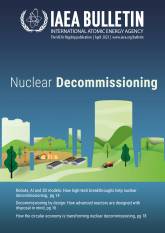
If you would like to learn more about the IAEA’s work, sign up for our weekly updates containing our most important news, multimedia and more.
How the Circular Economy is Transforming Nuclear Decommissioning
Artem Vlasov

The French city of Grenoble used to be home to six nuclear facilities. After successful decommissioning, the site now serves as a centre for research and development in the field of renewable energy. (Photo: Unsplash)
The traditional linear economic model — extracting materials, turning them into manufactured goods and discarding them after consumption — is often criticized for creating a considerable amount of waste and pollution, as well as contributing to climate change and biodiversity loss. According to the United Nations Environment Programme International Resource Panel, the extraction and processing of natural resources account for about half of all global greenhouse gas emissions.
A departure from this model, known as the circular economy, offers a way to reduce waste and associated pollution. It is a model of production and consumption that seeks to effectively keep resources in use for as long as possible by reducing, reusing and recycling them.
When nuclear facilities are being decommissioned, the adoption of circular economy principles can provide many benefits. Decommissioning is a multidisciplinary process, typically lasting a decade or more, that involves the decontamination, dismantling and demolition of nuclear facilities so that a site can be released from regulatory control and reused. By recycling materials during this process, less waste is generated. This has the added benefits of lowering the cost of decommissioning and reducing the risk of delays.
“By applying the principles of a circular economy to decommissioning, we can reduce the amount of radioactive and non-radioactive waste to be disposed of and, at the same time, reduce the amount of raw material pulled out of the ground,” said Arne Larsson, radioactive waste technology and decommissioning manager at Cyclife Sweden. “Instead, we can reuse materials and equipment from existing installations, buildings and structures, and support making the site available again for other useful purposes.”
Worldwide, more than 200 nuclear power reactors have been shut down for decommissioning, while it is expected that hundreds of reactors currently in operation will be shut down and decommissioned in the coming decades. Today’s nuclear facilities are designed with decommissioning and waste management plans in place before the first brick is laid. The designs of nuclear reactors constructed in the 1960s and 1970s, by contrast, did not take circularity principles into account.
“ Adopting circular economy principles can provide significant drivers for minimizing waste, increasing efficiency and enhancing sustainability.
However, even old facilities can be effectively decommissioned by using circularity principles: up to 90 per cent of the non-radioactive materials at a nuclear power plant, such as metals, concrete and even work clothing, can be reused or recycled. Only around three per cent of materials, mainly spent fuel, are highly radioactive and, even then, more than 95 per cent of this fuel can be reprocessed to make new fuel and by-products.
“Adopting circular economy principles can provide significant drivers for minimizing waste, increasing efficiency and enhancing sustainability,” said Vladimir Michal, Acting Head of the IAEA’s Decommissioning and Environmental Remediation Section. “Decommissioning of nuclear facilities generates noteworthy amounts of materials that can be recycled and reused for other purposes.”
From six nuclear facilities to a renewable energy centre
Recycling is already widespread in decommissioning work. After dismantling, large metal components can be melted down and turned into ‘new’ metal to be returned to the economy. Equipment parts can be reused in other operating nuclear facilities, and materials from demolished buildings, such as concrete, can be used as fill material for site restoration or in other construction projects, including for houses and roads. For example, when the Australian research reactor MOATA, located in Sydney, was decommissioned in 2009, more than 85 per cent of the materials were reused or recycled.
Materials left over after decommissioning that cannot be decontaminated and cleaned up for reuse or recycling are disposed of as radioactive waste in repositories of different types until it no longer presents a hazard to humans or the environment (see here).
There are several examples of repurposed nuclear sites, including nuclear power plants, research reactors and other facilities used in medicine or industry. Nuclear power plant sites can be turned into waste processing and storage facilities or research centres for training operating personnel. The sites can become industrial parks and buildings can be given new life through repurposing for other conventional industries, attracting businesses and creating new jobs.
In the French city of Grenoble, six nuclear facilities, including three research reactors, one laboratory and two radioactive waste storage facilities, were successfully decontaminated and dismantled in 2012. The site is now used as a research and development centre for green energy technology and renewable energy sources, focusing on electric vehicles, batteries and hydrogen.
The IAEA provides a space for countries, organizations and individuals to cooperate and share knowledge and technology in the field of decommissioning. The IAEA’s e-learning platform contains lectures on decommissioning, environmental remediation, radioactive waste and spent fuel management.
The IAEA’s International Decommissioning Network (IDN) was set up in 2007 to provide a forum enabling professionals involved in decommissioning to collaborate and interact. In addition, the IAEA supports capacity building in Member States and facilitates expert missions, peer review and advisory services for decommissioning programmes and other related activities, such as radioactive waste and spent fuel management.
“The circular economy offers a promising approach to adapting the industry to sustainability and circularity, reducing the environmental impact and conserving resources for future generations,” Michal concluded.





